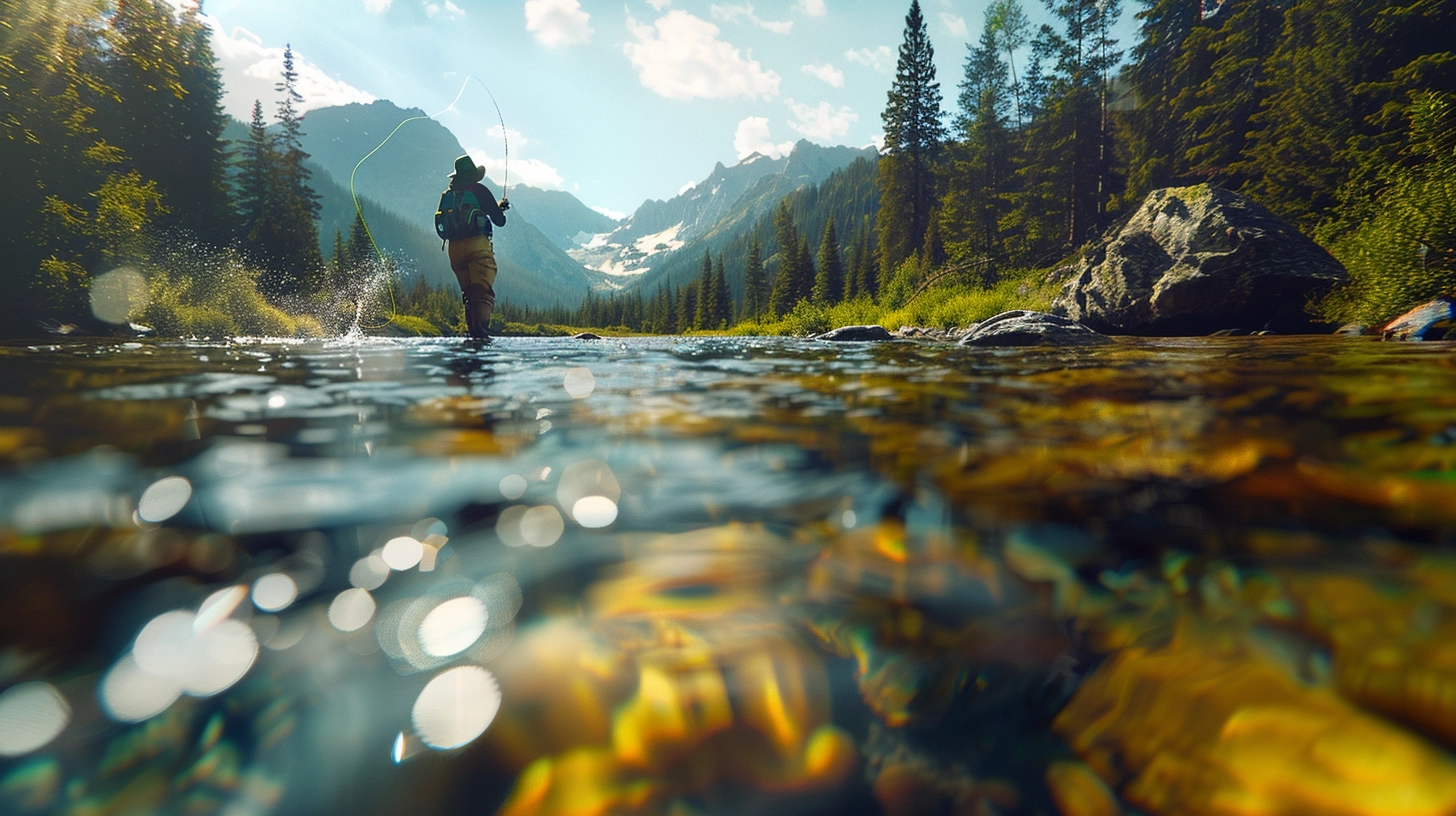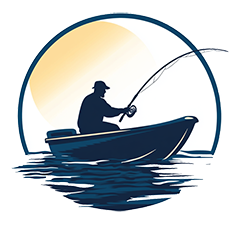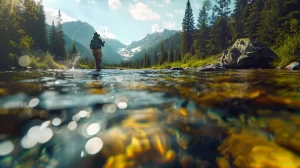
Exploring the realm of wilderness fishing tactics unveils a realm of strategic maneuvers and unconventional methods that go beyond the traditional rod and reel approach. From the ancient art of spearfishing to the hands-on skill of noodling, each technique requires a unique blend of patience, precision, and adaptability. As we delve into the intricacies of these wilderness fishing tactics, we uncover a world where innovation and resourcefulness are key to unlocking nature’s bounty. Through a combination of ancient wisdom and modern ingenuity, anglers can navigate the untamed waters with a sense of purpose and reverence for the wild.
Table of Contents
Essential Gear Selection
When preparing for wilderness fishing trips, selecting the right gear is crucial for a successful and enjoyable experience. To ensure both survival and fishing success in the wilderness, it is essential to pack a small fishing kit that includes lightweight and performance-oriented gear. Opt for compact backpack-friendly fishing rods, reels, and lines that are easy to transport, allowing for greater mobility in remote locations. Additionally, choosing ultralight tackle options will help minimize weight while still ensuring functionality when out in the wild.
Having the right gear not only enhances your fishing experience but also plays a vital role in wilderness survival. By matching lures to local trout species and their feeding habits, you increase your chances of a successful catch. It is important to adapt your lure selection based on water conditions and trout preferences to improve catch rates and make the most out of your wilderness fishing expedition. Remember, in the wilderness, the right gear can make all the difference between a memorable adventure and a challenging ordeal.
Understanding Fish Behavior
Understanding the behavior of fish is essential for wilderness anglers seeking successful and rewarding fishing experiences. Fish behavior is a complex interplay of various factors such as water temperature, oxygen levels, food availability, and the presence of predators. To improve your chances of a successful catch, it’s crucial to grasp the feeding habits and preferred habitats of different fish species. For instance, knowing whether a fish is a bottom feeder, surface feeder, or an ambush predator can greatly influence your fishing techniques.
[amazon box=”0071592911,1632203383″ grid=”2″]
Fish are creatures of habit, often exhibiting diurnal patterns where they are more active during dawn and dusk for feeding. These patterns can be vital information for anglers planning their fishing trips. Moreover, fish behavior can change based on environmental conditions like weather, water clarity, and seasonal variations. By staying attuned to these nuances in fish behavior, wilderness anglers can adapt their survival tips and fishing techniques to maximize their chances of a successful and fruitful fishing expedition.
Locating Prime Fishing Spots
To enhance your chances of a successful fishing expedition in the wilderness, mastering the art of locating prime fishing spots is crucial. When scouting for the perfect fishing spot, keep an eye out for areas with abundant structure such as fallen trees, rocks, or underwater ledges. These structures provide shelter and attract fish in search of food. Additionally, pay attention to signs of fish activity like jumping fish, swirling water, or feeding birds, as these are indicators of potential hotspots teeming with fish.
Consider the water temperature and depth variations, as different fish species have specific preferences for feeding and spawning conditions. Explore areas with current breaks such as eddies, points, and submerged vegetation where fish gather to conserve energy and ambush prey. Utilize resources like topographic maps, fishing apps, or local knowledge to uncover hidden gems like secluded coves, inlets, or backwaters where fish congregate. By being observant and strategic in your search for prime fishing spots, you can significantly increase your chances of a successful wilderness fishing adventure.
Effective Bait and Lure Choices
Selecting suitable bait and lures is essential for enticing a diverse range of fish species during your wilderness fishing excursions. When considering survival fishing techniques in backcountry fishing settings, it’s crucial to make wise bait and lure choices. Live bait such as worms, insects, and minnows are highly effective in attracting various fish species. Additionally, artificial lures like spinners, spoons, and plugs can mimic natural prey, making them enticing to predatory fish. For trout, fly fishing with realistic insect imitations from their diet can yield excellent results. To further enhance your chances of success, using scented bait or lures can be advantageous, particularly in murky waters. Moreover, adjusting the colors of your bait and lures based on water clarity and light conditions can significantly increase your catch rates. By being strategic in your bait and lure selections, you can optimize your fishing experience and increase your chances of a successful backcountry fishing adventure.
Stealth and Patience Techniques
Employing stealth and patience techniques is crucial for maximizing success in wilderness fishing endeavors. To enhance your stealth, consider wearing camouflage clothing and moving slowly and deliberately to fishing spots. Staying low to the ground or water surface can help minimize visibility and increase your chances of getting closer to the fish without startling them. Observing fish behavior and being patient are key components of successful fishing. By waiting for the right moment and making precise casts, you can improve your chances of a successful catch.
Utilizing natural cover such as rocks, trees, or vegetation can help conceal your presence, allowing you to blend into your surroundings and remain unnoticed by the fish. Avoid sudden movements and loud noises that could alert the fish to your presence, opting for a quiet and stealthy approach instead. By incorporating these stealth and patience techniques into your wilderness fishing strategy, you can significantly improve your chances of a successful fishing expedition.
Handling and Releasing Fish
When transitioning from employing stealth and patience techniques in wilderness fishing to handling and releasing fish, it is crucial to prioritize the well-being of the fish through proper techniques and care. To ensure the fish’s health, it is important to wet your hands before handling them to protect their slime layer and reduce stress. Additionally, using barbless hooks can minimize injury and make hook removal easier, promoting a safer catch-and-release process.
When handling a fish, always support it gently and avoid squeezing or dropping it, as this can cause harm. Proper catch-and-release techniques should be practiced to enhance the fish’s chances of survival after being released back into the water. Remember to minimize air exposure and release the fish quickly to improve its likelihood of thriving post-release. By following these guidelines for fish handling and release, you can contribute to the conservation and sustainability of wilderness fish populations while enjoying the freedom of the great outdoors.
Weather and Seasonal Considerations
Understanding the impact of weather conditions and seasonal variations is essential for successful wilderness fishing expeditions. Weather conditions, including temperature, wind speed, and precipitation, play a significant role in influencing fish behavior and feeding patterns. Similarly, seasonal variations such as spawning periods and shifts in water temperature can affect the location and activity of fish in the wild.
Fish behavior is closely tied to changes in weather fronts and barometric pressure, which can trigger increased activity and feeding. By grasping how weather and seasons influence fish movement, anglers can pinpoint optimal fishing times and locations. Adapting fishing techniques based on weather forecasts and seasonal changes is crucial for enhancing the effectiveness of wilderness fishing expeditions.
When considering weather and seasonal factors, anglers should also pay attention to the type of fishing line used. Different weather conditions may require adjustments in line strength or type to ensure successful catches. By staying informed and flexible in their approach, anglers can maximize their chances of a rewarding fishing experience in the wilderness.
Safety Precautions in the Wilderness
What essential measures should anglers take to ensure their safety during wilderness fishing expeditions? Safety precautions are paramount when venturing into the wilderness for fishing adventures. Before setting out, always inform a trusted individual of your plans and expected return time. Carrying a well-equipped first aid kit is crucial to address common injuries like cuts, scrapes, and insect bites that may occur during your wilderness fishing trip. Stay vigilant of your surroundings, including potential hazards such as wildlife encounters, rough terrain, and abrupt weather changes. Hydration is key, so ensure you have an adequate water supply for the duration of your expedition. Additionally, familiarize yourself with fundamental survival skills like constructing a shelter, starting a fire, and signaling for help in case of emergencies. By adhering to these safety precautions and being prepared with first aid and survival skills, anglers can enjoy their wilderness fishing experiences while prioritizing their well-being.
Leave No Trace Principles
Respecting the natural environment is paramount for wilderness anglers, and adhering to Leave No Trace principles ensures minimal impact on the ecosystem while engaging in fishing activities. When heading out for backcountry fishing trips, it’s crucial to follow these guidelines to protect the wilderness you enjoy. Packing out all waste, including fishing lines, hooks, and any trash, is essential to keep the environment pristine. Additionally, maintaining campsites by leaving no signs of your presence and avoiding disturbance to natural habitats helps preserve the ecosystem’s balance.
Responsible wilderness practices also involve bear-proof food storage to prevent attracting wildlife to your campsite. By following these principles, anglers contribute to the conservation of natural ecosystems and ensure that future generations can continue to enjoy the beauty of the wilderness. Remember, the goal is to leave no trace of your visit, leaving the environment as undisturbed as possible for others to experience the serenity and freedom of the great outdoors.

